| 1 | Ball python |
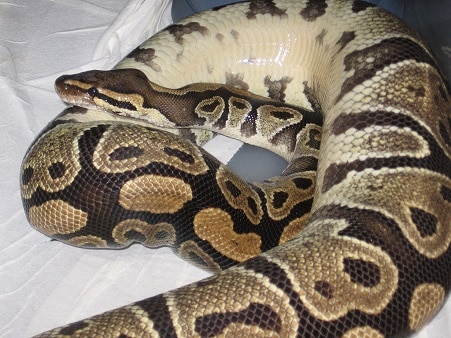
Maximum length: 182cm.
There are 40 python species worldwide, yet of those, only 10 are “true” pythons: those belonging to the genus simply titled Python. Several classics are no longer included, such as the reticulated python, the longest snake worldwide, which was reassigned to the Malayopython genus. The true pythons diverged from the rest an estimated 33.62 million years ago, and the ball python (AKA Python regius) is one that took shape in Africa.
At an average of 1.1 metres, this is the shortest true python worldwide, yet the most popular in captivity. Alongside the boa constrictor and corn snake, they might be the most popular captive snake full stop. Ball pythons are completely harmless, and curl up into a ball with their head in the centre if frightened, which led to their name. They’re capable of delivering painful bites, but very rarely do so.
Ball pythons inhabit over a dozen countries, sticking to central and western African nations such as Nigeria and Ghana. Thousands are scooped up from the wild and exported each year, and another batch are bred in dedicated facilities. Despite this, their wild numbers are still high, as this species naturally has high population densities.
Ball pythons spend their days lurking in the grassy undergrowth, waiting to ambush small mammals such as soft-furred mice (an actual species) and Gambian pouch rats. They’re common in farmland, and are such a peaceful local resident that many Nigerians and Ghanaians worship them, even building shrines.
| 2 | Burmese python |
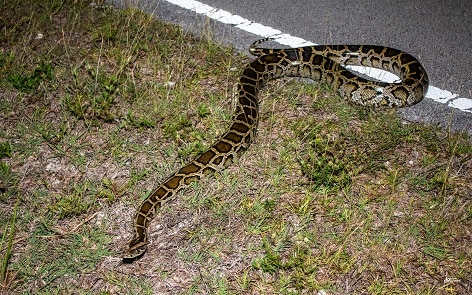
Maximum length: 579cm.
This was the first python to be described by science, back in 1758, originally receiving the title Coluber molurus. These days, it belongs to the true python genus and is known as Python bivittatus. Burmese pythons are most famous as an invasive species in Florida, where they number an estimated 300,000, and are so camouflaged that they can be invisible mere metres away from an environmental officer wielding a rifle. But they have a natural home too, specifically extreme eastern India through to central Thailand, with most of their empire being located in Myanmar.
Burmese pythons are one of the longest snakes worldwide, with a record length of 5.79 metres. They mainly eat mammals and birds, and can fast for as long as 18 months. Throughout this fasting, their stomach and intestinal volume shrink, and their stomach acid output downregulates. Being so huge, they’re capable of eating huge prey, including deer and occasionally alligators.
Burmese pythons are far more commonly found near water than the ball python. As youths, they can ascend trees for a nice lookout, but as bulky adults they restrict themselves to the ground. Burmese pythons are a non-venomous constrictor, but have savage teeth which they use to grip prey, and wouldn’t feel pleasant if digging into your arm. Enhanced length means enhanced reproduction, as the Burmese python can lay over 100 eggs at once.
| 3 | Central African rock python |

Maximum length: possibly up to 6 metres.
The largest true python, and the third longest snake worldwide. Central African rock pythons (Python sebae) have taken control of Africa, and nothing can persuade them to relinquish their grip. Their average length is already 3-3.5 metres, and the longest push to 6 metres, with an unconfirmed, though seriously considered sighting of 9.81 metres in Ivory Coast in 1932.
In captivity, African rock pythons can grow by 10cm a month, and they hold the official record for largest prey in snakes, a 150 pound hyena. Central African rock pythons are only found south of the Sahara, sticking primarily to the west and centre of Africa. They range from Gambia in the extreme west, to a southerly point of Tanzania.
Rather than jungles, Central African rock pythons prefer intermediate environments such as grassy areas next to rivers, intermingled with decent amounts of rocks. They’re commonly spotted on dirt tracks, and are mainly an ambusher, but also prowl around slowly and steadily, like a tortoise, only bursting into life when they pounce on unsuspecting prey.
Central African rock pythons coexist peacefully with ball pythons, because they occupy different ecological niches. The ball python is miniature and focusses on small darting mammals, while rock pythons can swallow up larger African fauna. These true pythons sometimes live side by side, as there’s no competition between them. However, where they do coexist, ball pythons are usually much more abundant.
| 4 | Southern African rock python |
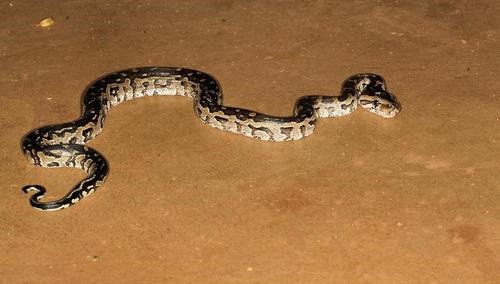
Maximum length: 580cm.
The southern African rock python (Python natalensis) is virtually identical to its central cousin, but has just enough differences to make it a separate species. The southern form was officially separated in 1999, after originally being a subspecies, and occupies South Africa, Zimbabwe, Botswana, and Tanzania, with a northern limit of southern Kenya. Their personality is identical, being a massive constrictor which prowls slowly around rocky, grassy areas. However, there’s several subtle physical differences. Southern African rock pythons have a slenderer head like a crocodile, rather than a bulky boulder shape.
In the central rock python, the head markings are better defined, with striking colour contrasts. In the southern species, everything is more muddied. Northern versions usually have brighter colours. Southern versions are drabber and duller, but have their own speciality, as a few can be near black.
Then things get even more technical; in the southern version, the frontal scales (forehead scales between the eyes) are separated, while in the northern versions, they’re usually whole. The two species overlap in Tanzania, where they live side by side in a few areas. They do this while rarely interbreeding, providing more evidence that they’re fully independent species. The southern rock python doesn’t quite reach the southern tip of Africa, fizzling out in the eastern cape.
| 5 | Blood python |
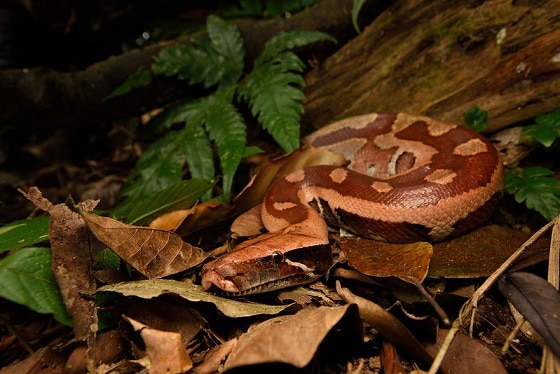
Maximum length: 2 metres.
A thick-bodied python of peninsular Malaysia and eastern Sumatra (Indonesia). This species is a resident of thick, stifling jungles, including the swampiest areas which no human would ever dare to venture to. More recently, they’ve developed a liking for manmade palm oil plantations, due to the scores of tasty rats that flock there.
At an average of 1.5-2 metres, blood pythons are relatively short, but have an exceptionally bulky body, which is perfect for slamming into unsuspecting prey (and maybe humans) with an explosive pounce. This species is part of a 4 member blood python sub-complex within the Python genus, with other members including the Borneo python and Sumatran short-tailed python. Of the 4, this is the member where the namesake bloody red or orange markings show up most. It’s also the largest member, growing to 2.6 metres versus just 2.1 metres (except for extreme flukes).
Because of the striking patterns, blood pythons are extremely popular in captivity, so much so that the species is now under pressure. In 2022, Indonesia reported that 2195 wild caught blood pythons were exported annually, simply for the pet trade. But an illegal trade of 10,000 per year is also believed to exist, sidestepping quotas imposed by the government. There’s also a legal trade in leather – between 2004 and 2020, 67,950 small leather products (like wallets) made from blood pythons were exported from Indonesia.
| 6 | Indian python |
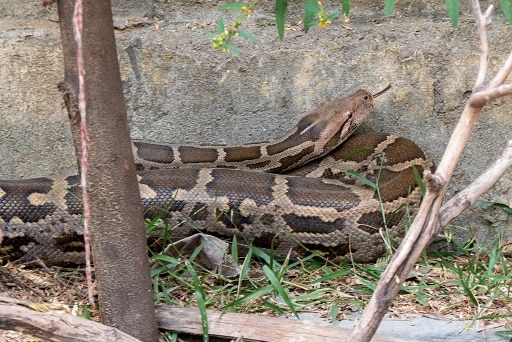
Maximum length: 460cm (so far).
A close relative of the Burmese python, which was only separated into its own official species in 2009. The Indian python lives in eastern Pakistan and extreme western Bangladesh, but is otherwise an exclusively Indian snake, which inhabits virtually the whole country.
The Indian python is one of the longest snakes in the world, though not matching the African rock python. A 1990 study in Keoladeo National Park found that 2.7-3.3 metres was a typical length. Compared to other true pythons, they have an exceptional tolerance for cold weather, including in hibernation.
The Indian and Burmese pythons are separable with a few expert ID hints. The clearest is a series of pink stripes on the head, which Burmese pythons completely lack. Indian pythons are lighter coloured overall, generally a mixture of beige and brown, versus grey for the Burmese. The Indian python has a unique diamond-shaped spot on its head, and their habitats also differ, as Indian pythons are generally found in drier, more arid environments than the Burmese.
Like many snakes, Indian pythons have poor eyesight, and rely heavily on scent to track down prey. They’re non-discriminate and swallow up a wide variety of animals, particularly mammals and birds. Indian pythons wreak havoc on Indian livestock, causing farmers to kill them out of policy and not just fear. July and August are their most active months.
| 7 | Sumatran short-tailed python |
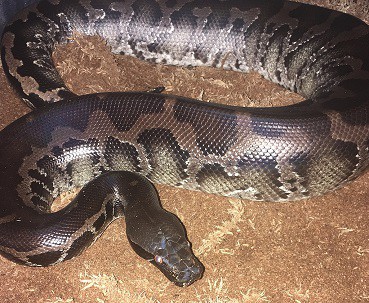
Maximum length: around 2 metres.
The blood python’s less widespread cousin. The short-tailed python (Python curtus) is found exclusively on the island of Sumatra, Indonesia. The main blood python is also found here, but exclusively in the eastern half. Short-tailed pythons live only in western Sumatra, separated by the spine-like Barisan mountain range. It’s believed that the two species have no area of overlap.
Visually, shot-tailed pythons have significantly duller colours than their blood-stained cousin. They’re also shorter, averaging at 1.5-1.8 metres, but are just as thick. Their habitats are virtually identical, with humid swamps and manmade palm oil plantations being their preferred bases.
Like its two cousins, this species is overwhelmingly mammal-eating. A study analysed 2036 blood pythons and 181 Sumatran short-tailed pythons, and failed to find a single reptile prey. In the latter, there were 127 mammals and 8 other animals.
Sumatran short-tailed pythons are exceptionally long-lived, with one reaching 27.8 years. This is partly because of their slow metabolism and lazy lifestyle. Sumatran short-tailed pythons are also widely exploited for leather, with 100,000 being processed each year.
| 8 | Borneo python |
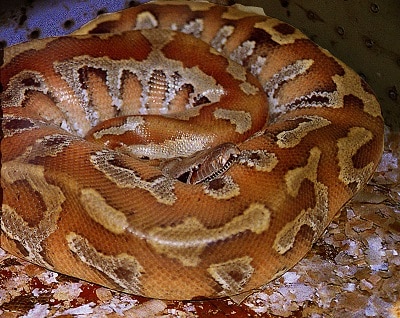
Maximum length: 2 metres.
The 3rd member of the blood python crew. The Borneo python sticks solely to its namesake island, which is divided between Indonesia, eastern Malaysia and Brunei. Unlike the Sumatran short-tailed python, it shares no landmass with its blood python cousin. This map has a handy breakdown of the 3 species.
The Borneo python brings back the bright colours of the blood python, with a glistening orange quality that helps them to blend in. The maximum recorded length is 2.1 metres, with a typical adult length of 1.3 metres (though with a crushingly thick body).
Despite being smaller, Borneo pythons lay more eggs per clutch than the blood python, at an average of 17.2. Male Borneo pythons tend to be slenderer and longer-headed than females, which are built like east German tanks.
Within the sub-group, the Borneo python and Sumatran short-tail are more closely related. The main blood python has an 8.9% genetic separation, while the former two are just 3% apart. Originally, the blood python was considered to be one monolithic species, but these exact genetic discoveries led to them being split. Borneo pythons and short-tailed pythons are estimated to have diverged 1.5 million years ago, after falling sea levels caused the two landmasses to separate.
| 9 | Anchieta’s python |
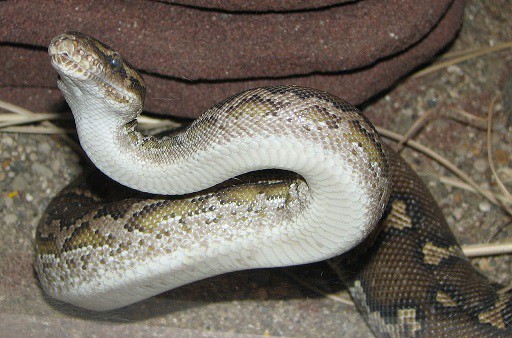
Maximum length: 231cm.
Africa’s rarest python. This is the ball python’s closest relative, but with a far narrower territory. Anchieta’s python lives exclusively in Namibia and Angola, and doesn’t overlap with the ball python at all. They average at just 1.2 metres, with a maximum length of 1.8 metres. This species is reddish brown or dark brown, contrasting against creamy white, jagged stripes. A thick head and pale underside are another two special features.
Anchieta’s python has a varied diet of mammals and birds, and in captivity, they’re said to be particularly fond of sparrows. Opinions differ on how common Anchieta’s python is within its territory. Some say they’re easier to find than African rock pythons, while others laugh and say that it’s an impossible task.
Anchieta’s pythons dwell in open areas like dry savannahs and rocky outcrops. They lay just 4-6 eggs per clutch, but younglings hatch at an especially large 50cm.
Anchieta’s pythons tend to lighten with age. Their defensive strategy is identical to their ball python cousin: curling into a ball and shielding their head and brain. Despite hundreds of miles of separation, this is a feature that has lingered on. Don’t expect to find this true python in your local pet shop any time soon. That said, they’re still more common than one Python member…
| 10 | Myanmar short-tailed python |
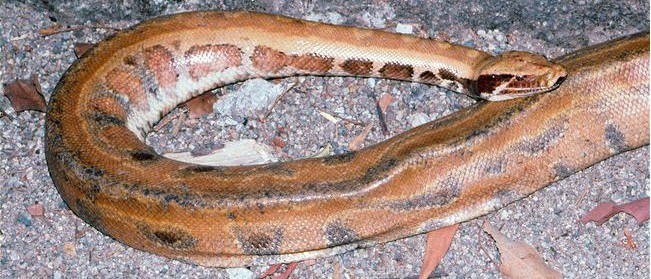
Maximum length: too few discovered to know. Probably 200cm.
The rogue potential 4th species of the blood python family. Virtually nothing is known of its diet or personality, for one simple reason – only one has ever been discovered. This specimen was found in 2002 in Kyaikhtiyo Wildlife Sanctuary at an altitude of 390 metres. Previously, only the Burmese python was known in this region, yet this python was unusual.
It was bright orange, similarly to the blood python of Indonesia, yet was clearly differentiated by the vast number of ventral (belly) scales, at over 180. The Myanmar short-tailed python (Python kyaiktiyo) was granted species-hood in 2011, despite only one still being known. The war-torn nature of Myanmar has hampered research, yet Python kyaktiyo may be naturally rare.
It’s kind of unjust – the reticulated python does all the hard work establishing a python reputation, slithering through sewers and climbing lampposts, yet this obscure jungle weirdo is granted official “true” status instead. The Myanmar short-tailed python has smooth scales, and the sole captured female measured 150cm. Local Burmese people almost certainly know more than scientists at this stage.
